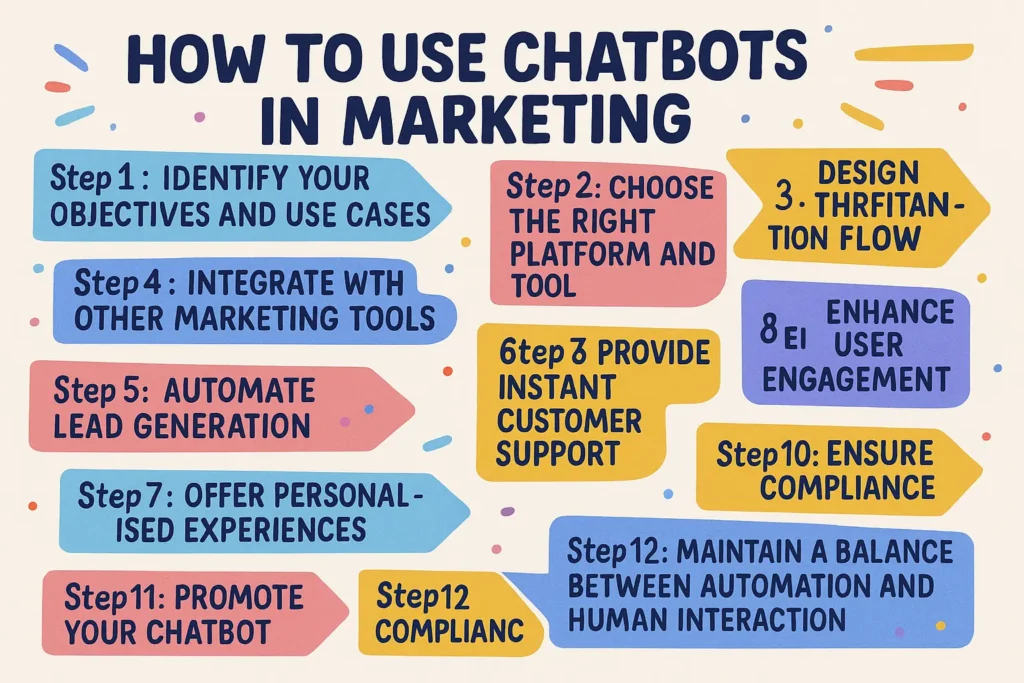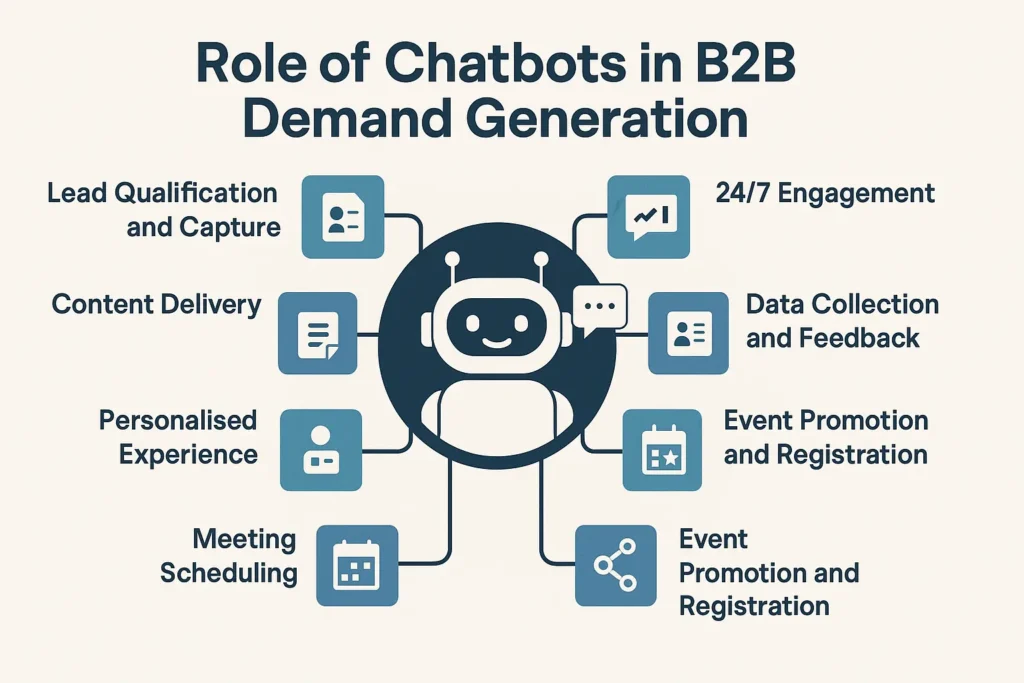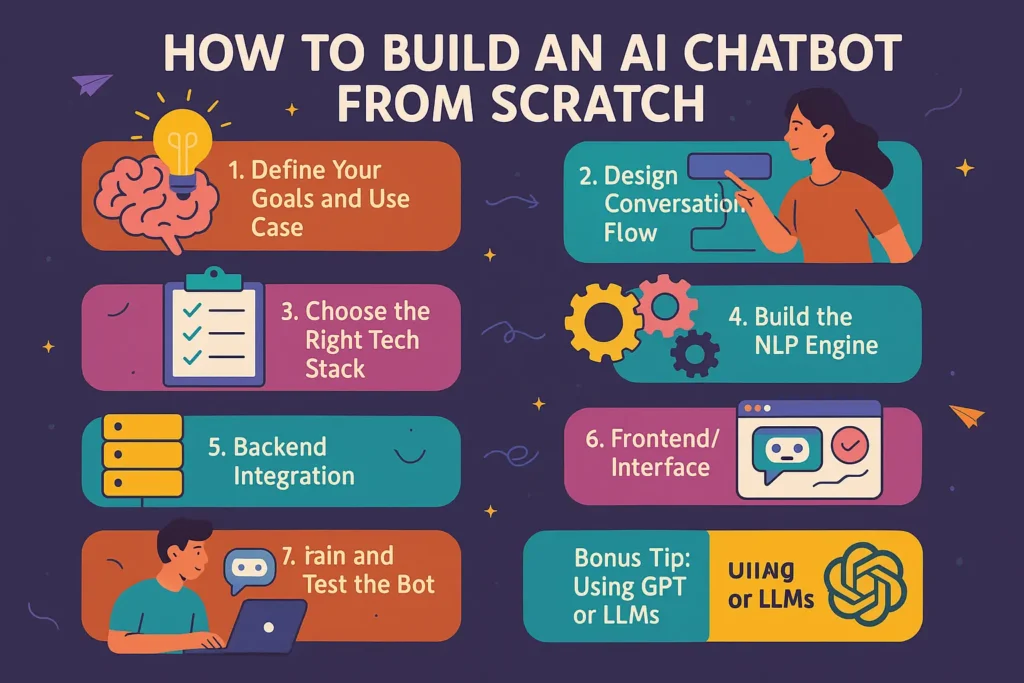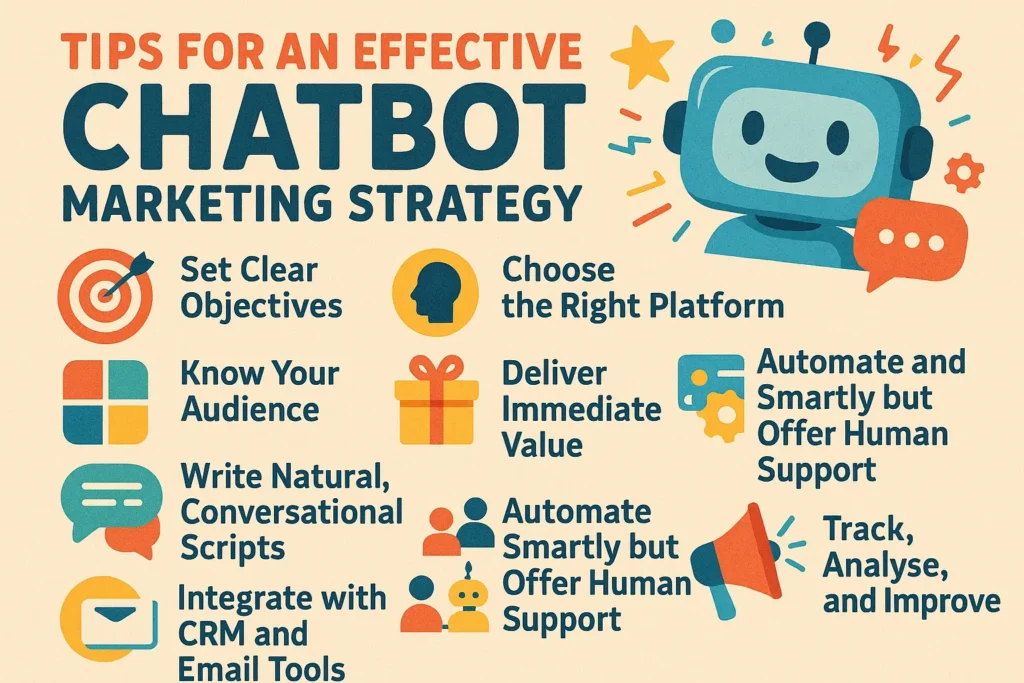Imagine having a tireless assistant who never sleeps, answers instantly, and handles countless conversations at once — no coffee breaks, no mood swings, just pure efficiency. That’s the magic of chatbots. In today’s fast-paced digital world, where customers expect lightning-fast responses and round-the-clock support, chatbots have become the unsung heroes of customer interaction.
Whether guiding users through a website, resolving common queries, or helping with purchases, these AI-powered conversational agents are revolutionising how businesses communicate. They’re not just tools — they’re 24/7 brand representatives, sales assistants, and support agents rolled into one intelligent interface. So, what makes chatbots such a powerful asset for businesses of all sizes? Let’s explore.
Understanding Chatbots as a Marketing Automation Tool
In today’s fast-paced digital landscape, businesses constantly seek ways to streamline their operations while enhancing customer experience. One innovation that has transformed modern marketing is the chatbot—a powerful marketing automation tool that combines artificial intelligence with conversational engagement.
Chatbots are software programs designed to simulate human conversation. When integrated into marketing strategies, they can automate tasks like responding to customer inquiries, qualifying leads, sending personalised messages, and guiding users through sales funnels—24/7. This reduces the workload on human teams and ensures that customers receive instant support and information.
By leveraging data, chatbots can offer personalised interactions, helping marketers deliver customised content, recommend products, or remind users of abandoned carts. They can also integrate with CRM systems and other digital platforms to enhance lead-nurturing and customer retention efforts.
In short, chatbots are more than just virtual assistants—they’re strategic tools that can drive engagement, increase efficiency, and boost conversions. Incorporating chatbots into a marketing automation toolkit is smart for businesses aiming to scale while maintaining a strong customer connection.
What are Chatbots?
Chatbots are software applications designed to simulate human conversation, allowing users to interact with digital systems through text or voice. They can be as simple as rule-based systems that answer predefined questions or as advanced as AI-powered bots that understand context and intent using natural language processing (NLP).
There are two main types:
- Rule-based chatbots: follow set scripts and respond to specific commands.
- AI-powered chatbots: learn from user interactions and provide dynamic responses.
They are commonly used in customer service, marketing, e-commerce, and education to automate responses, handle queries, or guide users through processes.

What is Chatbot Marketing?
Chatbot marketing is a digital strategy that uses automated chat tools—commonly known as chatbots—to engage with customers, answer questions, promote products or services, and guide users through the sales funnel. These bots are typically integrated into websites, messaging apps (like WhatsApp, Facebook Messenger), or e-commerce platforms to provide instant, personalized responses without human intervention.
Chatbot marketing simulates human conversation and helps businesses provide 24/7 customer support, qualify leads, send reminders, run promotions, collect feedback, and even close sales. It’s a powerful tool for improving customer experience, saving time, and increasing conversions, especially in e-commerce, real estate, education, and healthcare industries.
Top Benefits of Using Chatbots for Marketing
Using chatbots for marketing offers several significant benefits that can enhance customer engagement, streamline operations, and boost conversions. Here are the key advantages:
- 24/7 Customer Engagement: Chatbots are always active, answering queries, suggesting products, and guiding users anytime, even outside business hours.
- Personalised User Experience: With access to customer data, chatbots can offer customised recommendations, increasing user satisfaction and conversion rates.
- Lead Generation & Qualification: Bots can ask relevant questions, capture user information, and qualify leads before passing them on to sales teams.
- Instant Response Time: Speed matters—chatbots provide immediate replies, reducing bounce rates and increasing user retention.
- Cost Efficiency: Automating responses and basic tasks helps businesses reduce staffing costs while maintaining high service levels.
- Data Collection & Insight: Bots track interactions, helping marketers analyse user behaviour and optimise future campaigns based on real-time feedback.
- Multichannel Integration: Chatbots can be deployed across websites, social media, and messaging platforms, ensuring a consistent presence where your audience is most active.
- Boosts Conversion Rates: Chatbots help guide users toward purchasing or signing up by providing timely nudges, product suggestions, and support.
- Handles Repetitive Tasks: They automate FAQs, bookings, confirmations, and order tracking—freeing up your team for strategic work.
- Supports Campaigns: Chatbots can deliver personalised messages, run quizzes, and distribute offers or coupons, enhancing campaign engagement.
How to Use Chatbots in Marketing

Using chatbots in marketing can streamline customer engagement, improve user experience, and increase conversion rates. Here’s a detailed guide on how to effectively integrate chatbots into your marketing strategy:
Step 1: Identify Your Objectives and Use Cases
Before implementing a chatbot, defining the primary goals you want to achieve is crucial. Every day, use cases for chatbots in marketing include:
- Lead generation: Chatbots can help qualify leads by asking relevant questions.
- Customer service: Providing instant answers to frequently asked questions (FAQs).
- Sales assistance: Helping users navigate through product offerings and complete purchases.
- Engagement and retention: Sending personalised messages to engage users and keep them returning.
- Survey and feedback collection: Gathering customer opinions or conducting market research.
Step 2: Choose the Right Platform and Tool
Select a chatbot platform or tool based on your business needs, ease of use, and features. Some popular chatbot platforms include:
- Intercom: Best for customer service and sales automation.
- Drift: Focused on lead generation and sales.
- Tidio: Offers easy integration for e-commerce sites.
- ManyChat: Great for Facebook Messenger marketing and integration with other social platforms.
- Chatfuel: A good option for building AI-driven chatbots without coding knowledge.
Consider your audience and where they spend the most time—whether on your website, social media platforms (like Facebook or Instagram), or messaging apps (WhatsApp, Telegram).
Step 3: Design the Conversation Flow
A chatbot should follow a structured and intuitive conversation flow. Design the chatbot’s dialogue to ensure that users have a smooth experience. Key points to focus on:
- Greeting: The first impression matters. Craft a welcoming message that sets the tone.
- Menu Options: Use buttons or quick replies to guide users toward specific actions or information.
- Personalisation: Use customer data (like name or preferences) to personalise conversations.
- Human Handover: Ensure the chatbot can smoothly transfer the conversation to a human agent if necessary.
- Escalation Points: Identify when a chatbot should escalate issues to a live agent.
You can use flowchart tools like Botmock or Chatbot.com to plan your bot’s interactions.
Step 4: Integrate with Other Marketing Tools
Integrating your chatbot with other marketing tools can enhance its effectiveness. Consider linking it with:
- CRM systems (e.g., Salesforce, HubSpot): This allows chatbots to store and retrieve customer data, creating more personalised experiences.
- Email marketing tools (e.g., Mailchimp, ActiveCampaign): Use chatbots to collect email addresses and automatically add them to email lists.
- Social media platforms (Facebook, Instagram): Connect your chatbot to Facebook Messenger, Instagram Direct Messages, or WhatsApp for cross-platform engagement.
- Analytics tools (Google Analytics, Hotjar): Monitor chatbot performance and gain insights into user behaviour.
Step 5: Automate Lead Generation
Lead generation is one of the most valuable uses of a chatbot in marketing. Here’s how to make the most of it:
- Capture Leads: Use the chatbot to engage users and collect information such as names, emails, and phone numbers. The bot can ask qualifying questions to determine if the lead is ready to buy.
- Nurture Leads: Once a lead is captured, the bot can automatically send follow-up messages or emails with relevant offers, resources, or content.
- Segment Leads: Based on the data collected, segment leads and target them with customised marketing messages or offers.
Step 6: Provide Instant Customer Support
Chatbots are excellent at answering FAQs and providing immediate assistance. This reduces the load on your human support team. Here’s how to make it effective:
- Answer Common Questions: Program the chatbot to answer the most frequently asked questions about your products or services.
- Provide Order Assistance: In e-commerce, bots can help customers track their orders, check stock availability, and process returns or exchanges.
- Create Knowledge Base: Feed the chatbot a knowledge base to handle common inquiries. The chatbot should be able to reference product details, delivery times, return policies, and more.
Step 7: Offer Personalised Experiences
Personalisation can be a huge driver of customer satisfaction and loyalty. Use the chatbot to gather information and offer personalised recommendations:
- Collect User Preferences: Ask customers about their preferences and tailor product or service recommendations accordingly.
- Use Data for Targeted Offers: Based on customer interactions, personalise promotions or discounts and send them via the chatbot.
- Location-Based Personalisation: Integrate geolocation services to offer localised recommendations or promotions.
Step 8: Enhance User Engagement
Engaging users through chatbots can increase interaction and encourage return visits. Some strategies include:
- Surveys and Polls: Use the chatbot to engage users with interactive surveys or polls. This helps gather insights and keeps customers involved.
- Quizzes and Fun Interactions: Design quizzes about your products or services that produce fun results or rewards.
- Gamification: Introduce gamified elements like badges, rewards, or challenges to incentivise customers.
Step 9: Monitor and Optimise Performance
Continuously monitor the chatbot’s performance and optimise it for better results:
- Track Metrics: Analyse engagement rates, response times, conversion rates, and customer satisfaction.
- Refine Conversation Flows: Regularly review the conversations and improve responses based on user feedback and behaviour.
- A/B Testing: Test different messages, flows, and actions to see what resonates best with your audience.
- Fix Errors: Look for common issues like broken links or unanswered queries, and update the bot accordingly.
Step 10: Ensure Compliance
Make sure your chatbot complies with legal regulations and privacy standards, such as GDPR for data protection. You’ll need to:
- Obtain Consent: Always ask for consent to collect personal data and inform users about how their data will be used.
- Data Security: Ensure that any sensitive information is encrypted and stored securely.
- Transparency: Communicate the chatbot’s capabilities and limitations to avoid customer frustration.
Step 11: Promote Your Chatbot
Let your audience know about your new chatbot. Some ways to promote it include:
- Social Media: Share on platforms like Instagram, Facebook, and Twitter.
- Website and Landing Pages: Embed the chatbot on your website or landing pages.
- Email Campaigns: Send an email announcing the chatbot and inviting users to try it.
- In-App Prompts: If you have a mobile app, use in-app notifications to encourage users to engage with the chatbot.
Step 12: Maintain a Balance Between Automation and Human Interaction
While chatbots are powerful, remember that some situations require a human touch. Ensure there’s a straightforward handover process from the bot to a human agent when necessary.
By following these steps, you can effectively use chatbots in your AI marketing strategy, enhance customer experience, and drive conversions.
Chatbot Marketing Examples
Chatbot marketing has become a popular tool for businesses to engage with customers and improve their marketing efforts. Here are some examples of how chatbots are being used in marketing:
1. Customer Support Chatbots
- Example: Many e-commerce sites, like Sephora, use chatbots to offer real-time customer support. These bots can answer frequently asked questions, provide product recommendations, and assist with order tracking.
- Marketing Goal: Enhance customer experience and increase sales through personalised interactions.
2. Lead Generation Chatbots
- Example: HubSpot uses chatbots on its website to engage visitors, gather information about their needs, and qualify leads. The bot can schedule a demo or direct the lead to a sales representative.
- Marketing Goal: Automatically generate and qualify leads, improving sales funnel efficiency.
3. Product Recommendations
- Example: H&M uses a chatbot that helps customers find outfits based on their preferences (style, size, colour, etc.) and even offers personalised suggestions.
- Marketing Goal: Personalise the shopping experience, increasing conversion rates and sales.
4. E-commerce Assistance
- Example: Macy’s utilises Macy’s On Call, a chatbot designed to assist shoppers in finding products in-store and navigate to the correct department.
- Marketing Goal: Improve in-store experiences, increase foot traffic, and help customers find products quickly.
5. Booking and Appointment Scheduling
- Example: L’Oréal implemented a chatbot to book beauty appointments and virtual consultations. It guides users through service options and allows them to select times and locations.
- Marketing Goal: Drive in-store or online service bookings, boost brand engagement, and increase loyalty.
6. Event Promotion
- Example: Pizza Hut used a chatbot on Facebook Messenger to promote a limited-time offer. Customers could quickly order a pizza directly through the chat interface.
- Marketing Goal: Promote special offers, increase customer engagement, and simplify ordering.
7. Interactive Surveys and Feedback Collection
- Example: Nike uses chatbots to gather feedback on customer experiences, store visits, and product satisfaction. The bot asks simple questions and guides customers through short surveys.
- Marketing Goal: Collect customer insights to improve products and services, while maintaining engagement with the brand.
8. Social Media Chatbots for Content Distribution
- Example: BBC News uses a Facebook Messenger chatbot to deliver the latest news and personalised content to users based on their interests.
- Marketing Goal: Increase engagement by delivering personalised content directly to users, leading to higher retention rates.
9. Cart Recovery Chatbots
- Example: Shopify allows merchants to use automated cart recovery chatbots that reach out to customers who have abandoned their carts, offering discounts or reminding them of items left behind.
- Marketing Goal: Reduce cart abandonment rates and recover potentially lost sales.
10. Entertainment and Engagement Chatbots
- Example: Disney has created a chatbot that lets fans interact with popular characters like Mickey Mouse, helping to promote new products or events through fun and engaging interactions.
- Marketing Goal: Boost brand engagement and create a fun, immersive user experience.
These examples showcase how versatile chatbots can enhance customer experience, promote offers, generate leads, and increase conversions.
Role of Chatbots in B2B Demand Generation

Chatbots play a significant role in B2B demand generation by automating and enhancing various touchpoints in the buyer journey. Here’s a breakdown of their key roles:
- Lead Qualification and Capture: Chatbots can engage visitors on B2B websites in real time, asking qualifying questions to identify high-intent leads and capturing essential contact details without human intervention.
Example: A chatbot can ask, “What’s your company size?” or “Are you looking for a demo?” and route qualified leads to sales. - 24/7 Engagement: In B2B, decision-makers may browse during off-hours. Chatbots ensure businesses are always available to answer questions, share resources, or book meetings.
- Content Delivery: Chatbots can intelligently recommend whitepapers, case studies, or blog posts based on the user’s input or behaviour, driving engagement and nurturing leads through the funnel.
- Personalised Experience: With integrations (like CRM or marketing automation tools), chatbots can personalise conversations based on past interactions, company name, or industry.
Example: “Hi [Name], I see you downloaded our finance report—would you like a walkthrough customised for fintech companies?” - Meeting Scheduling: Chatbots simplify scheduling sales calls or demos by integrating with tools like Calendly or Google Calendar, reducing friction in the buyer journey.
- Lead Nurturing: Chatbots can follow up with leads through email or in-chat reminders, keeping them engaged with relevant updates, webinars, or promotions.
- Data Collection and Feedback: They gather valuable data on customer pain points, objections, and preferences, helping marketing and sales teams refine their approach.
- Event Promotion and Registration: For webinars, conferences, or B2B product launches, chatbots can act as interactive registration assistants and share event reminders.
Chatbots are more than just support tools—they are strategic assets in B2B demand generation. They streamline lead qualification, accelerate sales cycles, and deliver personalised experiences that drive conversions.
How to Build an AI Chatbot from Scratch?

Building an AI chatbot from scratch involves several steps, including defining the use case, designing the conversation flow, choosing the right tools/tech stack, and deploying the bot. Here’s a high-level roadmap:
Step 1: Define Your Goals and Use Case
- Decide what the chatbot will do: e.g., customer support, lead generation, scheduling, etc.
- Define your target audience and their needs.
Step 2: Design Conversation Flow
- Map user intents (e.g., “book appointment”, “check order status”).
- Create sample dialogues (user questions + bot responses).
- Decide on fallback/error handling logic.
Step 3: Choose the Right Tech Stack
- Programming Language: Python, JavaScript (Node.js), etc.
- NLP Engine:
- Open-source: Rasa
- Cloud-based: Google Dialogflow, Microsoft Bot Framework, or Amazon Lex
- LLM-based: OpenAI GPT (via API), Meta LLaMA, etc.
Step 4: Build the NLP Engine
- Intent Recognition: Use NLP to detect what the user wants.
- Entity Extraction: Pull out data like names, dates, etc.
- Context Management: Remember past messages to maintain natural conversation flow.
Step 5: Backend Integration
Connect your bot to a database or external services (APIs) to fetch or send data.
Example: Get order status from your eCommerce backend.
Step 6: Frontend/Interface
- Choose your platform: Website, WhatsApp, Messenger, Telegram, or mobile app.
- Use chatbot frameworks or SDKs for integration (like Botpress, React Chatbot Kit, etc.).
Step 7: Train and Test the Bot
- Feed it sample conversations and edge cases.
- Use tools to simulate user behaviour and test for different intents and responses.
Step 8: Deploy and Monitor
- Host your bot on a server or cloud service (e.g., AWS, Azure, Heroku).
- Monitor interactions, collect feedback, and keep improving.
Bonus Tip: Using GPT or LLMs
If you’re using GPT (like OpenAI’s models), you can:
- Use a prompt-based approach with an API.
- Add retrieval-augmented generation (RAG) for knowledge base queries.
- Implement tools/plugins for interactivity (e.g., API calls, memory).
Chatbot Marketing: A Case Study
One of the most recent and impactful chatbot marketing case studies comes from Modi Builders, a prominent real estate developer based in Hyderabad, India. In early 2024, they implemented SmatBot’s AI-powered chatbot to enhance customer engagement and streamline lead generation.
Modi Builders & SmatBot: Real Estate Marketing Transformation
Background:
With over 30 years in the construction industry and projects totalling approximately ₹7,000 crores, Modi Builders sought to modernise their customer interaction approach. Their goal was to improve responsiveness, generate more qualified leads, and simplify the appointment booking process.
Implementation Highlights:
- 24/7 Availability: The chatbot provided round-the-clock assistance, allowing potential clients to conveniently inquire about properties.
- Lead Qualification: The chatbot effectively identified and qualified potential buyers by engaging visitors in real-time.
- Appointment Scheduling: Integrated scheduling features enabled users to book property viewings seamlessly.
- Multilingual Support: The chatbot serves a diverse clientele and offers interactions in multiple languages.
- Personalised Assistance: Users received property recommendations tailored to their preferences.
Results Achieved:
- 30% Increase in Appointment Bookings: The streamlined process significantly increased scheduled property visits.
- 25% Growth in Lead Generation: Enhanced engagement translated to more qualified leads.
- 5x Faster Issue Resolution: Customer queries and concerns were addressed more efficiently.
- 9.25% Boost in Website Traffic: Improved user experience attracted more visitors to their site.
Future Plans:
Building on this success, Modi Builders plans to integrate advanced features such as augmented reality for virtual property tours and further personalisation in customer interactions.
This case exemplifies how integrating AI-driven chatbots can revolutionise marketing strategies, enhancing customer satisfaction and increasing business efficiency.
Tips for an Effective Chatbot Marketing Strategy

Here are some practical and effective tips for creating a strong chatbot marketing strategy:
- Set Clear Objectives: Before you build your chatbot, define what you want it to accomplish. Whether it’s generating leads, boosting sales, offering instant customer support, or collecting user feedback—having a clear purpose will shape your entire strategy and help measure success through KPIs like engagement rate, response time, or conversion rate.
- Know Your Audience: Understanding your audience is key. Research their behaviour, preferences, and pain points. This allows you to build personalised conversational flows that resonate with your users, creating a smoother and more engaging experience.
- Choose the Right Platform: Deploy your chatbot where your target audience is most active. This could be your website, Facebook Messenger, WhatsApp, Instagram, or SMS. The right platform maximises reach and effectiveness.
- Write Natural, Conversational Scripts: Avoid robotic or overly formal language. Use friendly, relatable tones, and personalise messages with names or previous interactions. A human-like chatbot builds trust and keeps users engaged longer.
- Deliver Immediate Value: From the first interaction, offer something valuable—a discount code, personalised product recommendations, a helpful blog, or answers to FAQs. The quicker users see the benefit, the higher the engagement.
- Integrate with CRM and Email Tools: Connect your chatbot to your CRM or email marketing tools to collect and manage leads efficiently. This ensures timely and personalised follow-ups and helps move users through your sales funnel.
- Segment and Personalise Conversations: Use gathered data to segment your users based on interests, location, or buyer stage. Then customise messages accordingly. Personalised communication increases the chance of conversions.
- Automate Smartly but Offer Human Support: While your bot should handle routine questions, it should also know when to pass the conversation to a human. This blend of automation and human touch ensures that complex issues get resolved quickly.
- Promote Your Chatbot: Let users know your chatbot exists. Add it to your homepage, run social media ads, mention it in emails, or include CTAs like “Chat to claim your offer!” on landing pages to boost interaction.
- Track, Analyse, and Improve: Regularly review chatbot analytics—check engagement rates, drop-off points, and common queries. Use this data to improve scripts, refine flows, and make your chatbot more effective over time.
Power of Chatbots in Modern Marketing
In conclusion, chatbots are invaluable for businesses aiming to stay competitive in the digital era. They enhance customer engagement by providing personalised, instant, and 24/7 support, freeing up human resources for more complex tasks.
With their ability to streamline operations, automate lead generation, and deliver customised experiences, chatbots improve customer satisfaction and drive conversions and efficiency. Chatbots are becoming essential assets for B2B or B2C applications that help businesses maintain strong customer connections and scale their operations effectively.
FAQ’s
How do chatbots improve customer availability in marketing automation?
Chatbots provide 24/7 availability, allowing businesses to engage with customers anytime, regardless of time zones or working hours. This ensures that customer inquiries are addressed promptly, improving customer satisfaction and retention.
Can chatbots help in automating marketing communication?
Yes! Chatbots can automate scheduled customer communication, including sending reminders, follow-ups, and personalised marketing messages based on user interactions. This significantly enhances the efficiency and effectiveness of marketing campaigns.
Why is 24/7 availability important for businesses using marketing automation?
24/7 availability allows businesses to communicate with customers anytime, eliminating the barriers of time zones and working hours. This continuous engagement helps maintain a strong customer relationship and ensures timely responses, which is critical for customer satisfaction.
How do chatbots impact customer retention and satisfaction?
Chatbots ensure that customers feel heard and valued by providing immediate responses and automating communication, directly boosting satisfaction. Their ability to operate around the clock leads to a seamless customer experience, ultimately increasing retention.



